Common menu bar links
Institutional links
Diseases & Conditions
Health & Safety
Research & Statistics
Agency Information
Search Box
E-mail this page
Progress Report on Cancer Control in Canada
[Previous] [Table of Contents] [Next]
Cancer Screening
Screening attempts to identify cancer or its precursors early in the disease process, before symptoms appear. The goal of cancer screening is to reduce morbidity from the disease and increase the likelihood of survival through early treatment. However, screening will only be beneficial if early treatment options offer some advantage over later treatments. Although it seems obvious that survival chances are improved when cancer is detected earlier, this is not always the case.
Screening practices
Screening is offered to apparently healthy people through organized programs or on an opportunistic basis. Opportunistic screening occurs either when a physician or other care provider advises the patient to be screened or when the patient requests it. Organized screening programs are typically characterized by:
- the ability to identify individuals in the target population;
- measures to promote high coverage and attendance;
- adequate field and laboratory facilities;
- organized quality control;
- adequate facilities for diagnosis and appropriate treatment of confirmed cancer;
- a carefully designed and agreed upon referral system; and
- evaluation and monitoring of the program.
The benefits of organized screening programs include: the ability to recruit individuals in target groups, including the hard to reach; promotion of increased attendance for investigation or re-screening; decreased health care system costs; and the adoption of routine and ongoing quality assurance, evaluation and overall program monitoring.
In Canada, there are significant levels of cancer screening for four major cancers: breast, cervical, prostate and colorectal. Although there is interest in screening for other cancers (e.g. lung, liver, testicular, ovarian), to date there is little evidence of either a health benefit or of widespread adoption.
Provincial and territorial governments not only pay for most cancer screening tests performed in Canada but also promote (or discourage) the use of various screening modalities. The federal role has been to help support the development of screening policies and guidelines. This section describes current screening guidelines and programs in Canada for breast, cervical, colorectal and prostate cancer, and briefly discusses the emerging technologies of genetic testing.
Breast cancer
CANADIAN TASK FORCE ON PREVENTIVE HEALTH CARE GUIDELINESThere is good evidence for screening women aged 50–69 by clinical examination (CBE) and mammography. The best available data support screening every 1–2 years (1998) Current evidence does not support the recommendation that screening mammography be included in or excluded from the periodic health examination of women aged 40–49 at average risk of breast cancer (2001). Because there is fair evidence of no benefit, and good evidence of harm, there is fair evidence to recommend that routine teaching of breast self-examination be excluded from the periodic health examination of women aged 40–69 (2001). |
Breast cancer is the most common cancer among Canadian women and is second only to lung cancer as the leading cause of cancerrelated deaths in Canadian women. In 2000, 18,523 women were diagnosed with breast cancer, and 4,857 women died from it. Nearly one-half of all new breast cancer cases occur among women between the ages of 50 and 69 years. Women in this age category are believed to benefit the most from breast cancer screening by mammography.
A screening mammogram is an x-ray of the breast in a woman who shows no signs of breast cancer. It usually involves two views (films) of each breast. Mammograms can detect breast cancers at an early stage, often before tumours can be felt or have spread to the lymph glands. Mammograms will also detect more advanced breast cancers, as will clinical breast examinations performed by a carefully trained health professional. In trials of regular screening mammography among women aged 50 to 69 years, the chance of dying of breast cancer was reduced, on average, by 30%. However, to achieve this benefit, the quality of mammography must be high, and the procedure should preferably be offered through organized programs. Further, the population mortality benefits of mammography noted in the clinical trials were not apparent until 7 to 10 years after screening had begun.
In Canada, breast screening by mammography may be accessed either through an organized provincial/territorial program or through the fee-for-service sector. The majority of screening mammography is conducted in Canada within organized screening programs. Data on breast cancer screening can be obtained either from the organized screening programs or from surveys. Although self-reported data, in theory, include the results of all screening mammograms wherever they occur, survey data are known to overestimate the prevalence of mammography. Unfortunately, administrative data from the fee-forservice sector often do not differentiate between diagnostic and screening mammography, and do not capture screening mammography provided through global hospital budgets, limiting the usefulness of the data for monitoring screening.
The proportion of Canadian women aged 50 to 69 years who have undergone mammography has been estimated from cross-sectional data collected from the 1996–1997 National Population Health Survey (NPHS) and the 2000–2001 Canadian Community Health Survey (CCHS). Approximately half of Canadian women in this age group reported having had screening mammography in the previous two years in both the 1996–1997 and the 2000–2001 surveys. In the 1996–1997 survey, 43% of women in Saskatchewan reported having had screening mammography compared to 76% of women in Nova Scotia (Figure 1). This disparity was less in the 2000–2001 survey, with increases in the reported proportion of women having a recent screening mammogram in all but three provinces (British Columbia, Nova Scotia and Newfoundland and Labrador). In 2000–2001, the lowest mammography screening rate in the country was in Nunavut, where only 38% of women reported screening mammography in the previous two years.
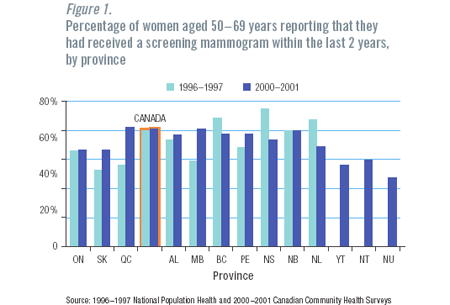
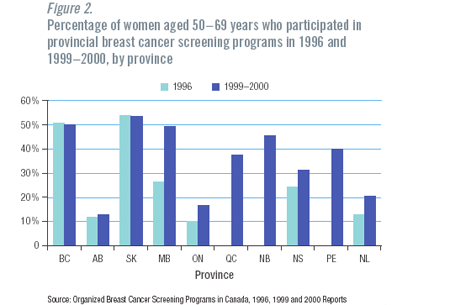
Organized screening programs
The number of provinces with organized screening programs increased from seven in 1996 to all ten in 2000. In 1999–2000, women aged 50–69 from British Columbia, Saskatchewan and Manitoba achieved 50% participation with biennial mammography screening. Other provincial programs had much lower participation (Figure 2). These participation rates for screening are well below the national target of at least 70% participation among women aged 50 to 69, set to achieve the expected impact on breast cancer mortality.
Groups at high risk of not having mammography
Women who are less likely to report mammography in the CCHS include those of lower educational levels, of single marital status, as well as those who are unemployed and those with a place of birth outside North America, Europe or Australia.
Clinical breast examinations and self-examinations
Clinical breast examinations (CBEs) can identify a small number of cancers that would not be detected by mammography. Data on self-reported CBEs are available for three provinces (Newfoundland and Labrador, New Brunswick, and Ontario) from the 2000–2001 CCHS. Although roughly one-half of all women aged 18 years and older reported having had a CBE within the previous 12 months, more than one in five reported that they had never had one. Although most CBEs are conducted on an opportunistic basis, organized programs in five provinces (Manitoba, Ontario, Nova Scotia, Prince Edward Island, and Newfoundland and Labrador) offer CBE in addition to mammography.
The Canadian Task Force on Preventive Health Care Guidelines recommend against the teaching of breast self-examination (BSE) as part of the periodic health examination. However, many provinces and territories continue to promote its use. The Canadian Cancer Society encourages women to perform BSE to help them learn what is normal for their breasts so that they will be able to notice any changes.
Cervical cancer
CANADIAN TASK FORCE ON PREVENTIVE HEALTH CARE GUIDELINESAnnual screening is recommended following initiation of sexual activity or at age 18; after two normal smears, screen every three years to age 69. Consider increasing frequency for women with risk factors: age of first sexual intercourse < 18 years, many sexual partners or having a consort with many partners, smoking or low socioeconomic status. There is fair evidence to include the Pap smear in the periodic health examination of sexually active women. (1994) |
Cervical cancer is the 12th most commonly diagnosed cancer among women in Canada. In 2000, there were 1,358 newly diagnosed cases and 398 deaths attributable to cervical cancer. While cervical cancer is relatively uncommon in Canada, it is the third most common cancer in women worldwide, and is the second leading cause of cancer deaths among women in developing countries.
Progression of the precursors of invasive cervical cancer is largely preventable if they are detected by effective screening and then treated. The Papanicolaou (Pap) smear test involves collecting cells from the surface of the cervix of asymptomatic women, which are then deposited on a slide, stained and examined for abnormalities. If the presence of pre-cancerous changes is confirmed, the cervix is then examined for abnormalities by a physician trained in colposcopy, so that treatment designed to prevent invasive cervical cancer can be provided. Increasingly, screening programs are investigating or moving to liquidbased cytology collection systems, neural-net screening and re-screening tools, and computer algorithms for selecting slides for screening or re-screening.
International studies have shown that in a wellconducted program, with expert cytology and high compliance from women offered screening, the risk of invasive cervical cancer developing in screened women can be reduced by more than 90%. In Canada, the reduction in agestandardized death rates from cervical cancer, from 7.3 per 100,000 women in 1969 to 2.2 per 100,000 in 2000 (Figure 3), is believed to be largely the result of cervical cancer screening.
The proportion of Canadian women who report having had a Pap smear test within the previous three years has been estimated from data collected from the NPHS and the CCHS. Data from the 1994–1995 NPHS and 2000–2001 CCHS suggest little change over time (Figure 4), reflecting the high proportion of women who reported having had a recent Pap smear test (73%) in both surveys. The proportion of women screened ranged from a low of 66% in Quebec in 1994–1995 and Nunavut in 2000–2001 to a high of over 80% in Alberta in 1994–1995 and Nova Scotia and Yukon in 2000–2001. The percentage of women tested varied by age, the lowest rates being observed for the youngest (20–24 years) and oldest (65–69 years) age groups (Figure 5). In both surveys, less than one-half of women aged 18 to 19 years of age (data not shown) reported ever having had a Pap smear test; the prevalence of testing increased with successive age groups and peaked among women aged 25 to 34. After this, there was a gradual decline in the proportion of women being tested.

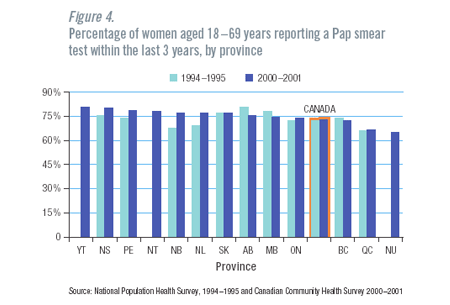
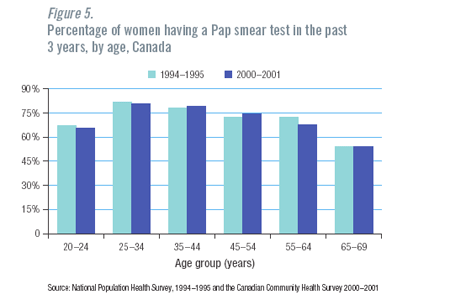
Organized screening programs
Eight provinces have screening programs for cervical cancer (all but Quebec and New Brunswick). These programs vary considerably in scope. Only Saskatchewan issues initial personal invitations for screening. British Columbia uses a single, centralized laboratory service; the Ontario program does not even receive laboratory results. Most programs do not have a system in place to recall women for routine re-screening.
High-risk populations
Women of low socio-economic status, Aboriginal women and women born outside of North America, Europe or Australia were less likely to report in the CCHS that they were recently screened for cervical cancer.
Colorectal cancer
CANADIAN TASK FORCE ON PREVENTIVE HEALTH CARE GUIDELINESCanadian Task Force on Preventive Health Care Guidelines: There is good evidence to include annual or biennial fecal occult blood testing (FOBT) and fair evidence to include flexible sigmoidoscopy in the periodic health examination of asymptomatic people over 50 years of age. There is insufficient evidence to make recommendations about whether only one or both tests should be performed. There is insufficient evidence to include or exclude colonoscopy as an initial screening test in the periodic health examination of people in this age group (2001). |
Colorectal cancer (CRC) is the third most common cancer in Canada, after breast and lung cancer in women and prostate and lung cancer in men. In 2000, there were 18,397 newly diagnosed cancer cases and 7,927 deaths attributable to CRC.
CRC is believed to develop from a benign tumour or polyp found in the bowel, though some of these may be “flat adenomas” and therefore difficult to detect. These polyps develop over a period of time (at least 10 years) on the bowel wall and later invade the wall and other organs. Approximately two-thirds of these cancers are found in the large intestine and onethird in the rectum.
Screening for CRC may be done through a fecal occult blood test (FOBT). As bowel cancers can bleed, the FOBT is used to detect small amounts of blood in the stool. This can lead to a diagnosis of the disease at an earlier stage, when it can be treated more effectively, therefore reducing mortality. Studies show that regular FOBT testing may lower the mortality rate of CRC by about 20%. The FOBT could also lead to detection of some pre-cancerous polyps, as polyps can also bleed.
There are no organized population-based screening programs for CRC in Canada; screening is currently done on an ad-hoc basis. Thus the potential effect of screening on reducing CRC mortality in Canada is not known. While there has been a decline in CRC mortality, it seems unlikely that much, if any, is due to screening.
Both the Canadian Cancer Society and the National Committee on Colorectal Cancer Screening (NCCCS) support an organized approach to CRC screening to ensure that individuals 50 years of age and over have a FOBT at least every two years. They suggest that programs include follow-up for positive tests with appropriate definitive tests — colonoscopy, double contrast barium enema or sigmoidoscopy. The cost-effectiveness of CRC screening is comparable to that of screening mammography. However, no organized program with compliance at the effective level has yet been achieved anywhere in the world because of relatively poor acceptance of the FOBT. In Ontario, a screening program was proposed for everyone in the province over the age of 50 but has not yet been initiated because of concerns over its feasibility.
Given the high incidence of colorectal cancer and the benefits of early detection on treatment and survival, further discussions on establishing population-based CRC screening programs are required. However, these discussions must also consider the effectiveness of screening relative to greater emphasis on prevention.
Prostate cancer
CANADIAN TASK FORCE ON PREVENTIVE HEALTH CARE GUIDELINESProstate Specific Antigen (PSA) testing: Exclusion is recommended on the basis of low positive predictive value and the known risk of adverse affects associated with therapies of unproven effectiveness. Fair evidence to exclude routine screening with PSA from the periodic health examination of asymptomatic men over 50 years of age. Digital Rectal Exam (DRE): Poor evidence to include or exclude DRE from the periodic health examination (PHE) for men over 50 years of age; while DRE has limitations in its ability to detect early prostate cancer, there is insufficient evidence to recommend that physicians who currently include DRE in their examinations should change that behaviour (1994). |
Prostate cancer is the most frequently diagnosed cancer and the second most common cause of cancer-related deaths among men. In 2000, there were 18,477 newly diagnosed cancer cases and 3,718 deaths attributable to prostate cancer in Canada. While early detection through screening may increase the chances of successful treatment, there is currently no screening test for prostate cancer that is recommended by the Canadian Task Force.
Several screening tests, including the prostate specific antigen (PSA) test, digital rectal examination, transrectal ultrasonography and magnetic resonance imaging have been considered to date. The PSA test is a fairly sensitive blood test that measures levels of the PSA protein released from the prostate gland. Prostate cancer is clinically heterogeneous, and although some prostate cancers are aggressive, most are slow growing. Unfortunately, the PSA test identifies not only those cancers that should be treated but also small and slowly growing prostate cancers that would never have caused symptoms in the individual’s lifetime. Not only are the detection and treatment of these cancers unnecessary, there is also a risk of substantial complications, including postoperative mortality, incontinence and impotence.
There has been an increase in PSA testing across Canada since the early 1990s. A national survey, conducted by Health Canada, the National Cancer Institute of Canada and the Institute for Clinical Evaluative Sciences in Ontario in 1995, reported that 15% of Canadian men over age 40 had had a PSA test since 1990. Results from the 2001–2002 CCHS indicate that 43% of men over the age of 40 have ever had a PSA test (Figure 6). While most PSA tests are done for the purposes of screening, PSA tests are also used to help diagnose symptomatic prostate cancer and to monitor prostate cancer progression.
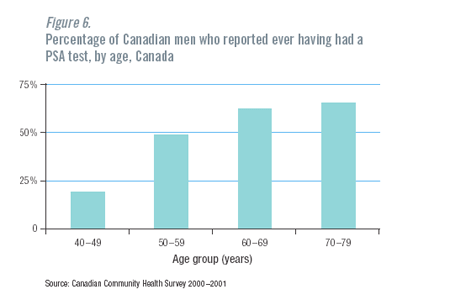
In spite of this increase in PSA testing, there is little evidence to suggest that patients who have been screened have better outcomes than individuals who are not screened. While prostate cancer mortality has been declining since the mid 1990s, it is unclear that this is due to screening. The utility of population PSA screening will be determined by two large ongoing screening trials in the U.S. and Europe.
Emerging technology: genetics and screening for cancer
Cancer is a disease that occurs primarily because of mutations in genes controlling cell growth and DNA repair. There has been a great increase in knowledge of genes and cancer in the last decade, most recently from the Human Genome Project. Genetics may eventually play an important role in screening for cancer, permitting the identification of individuals at risk of a specific cancer, leading to specific screening strategies for individuals or family members.
When genetic information indicates an increased risk of a cancer, those at risk may undergo screening at an earlier age in an attempt to detect a cancer at a more treatable stage. Genetic testing of a person with cancer can help clarify the risk to offspring and serve as the basis for subsequent genetic counseling of the offspring or family with respect to the medical situation and the adoption of strategies to minimize subsequent cancer risk.
Routine DNA-based genetic testing for high-risk genes (such as BRCA 1 or 2 for breast cancer) is currently not practical (or even desirable) in Canada, although it is being made available for high-risk families or individuals in some programs. Even in high-risk families, a negative screening test is only useful if it is known that the genetic defect being tested for is present in affected family members (i.e. that you are testing for the right gene). In practice, this type of high-risk genetic susceptibility is uncommon, and the proportion of cancers caused by such predisposition is low (about 5% for breast or colon cancer, less for most other cancers, except for retinoblastoma in children). In contrast, it is now appreciated that the genetically determined differences in the way people metabolize chemical carcinogens explain differences in the susceptibility of individuals to cancer. A major research endeavour is currently under way to characterize these genetic differences.
Beyond the high costs of genetic testing, there are also potential problems associated with patient privacy and discrimination. Who should have access to genetic information, and for what purposes should such information be used? The potential for discrimination regarding employment and access to health insurance is considerable, and safeguards against inappropriate use are being developed.
Future challenges
Screening has the potential to reduce morbidity and mortality through early treatment, as evidenced by the effectiveness of screening for cervical cancer. The primary challenges for cancer screening in coming years is to:
- improve and maximize the use of organized screening programs where such programs exist;
- determine how best to offer population screening for cancers where there is evidence of effective screening tools, but no organized program to support their use;
- continue research into screening methods for which there is not yet sufficient evidence to advocate their use.
Breast cancer screening challenges
Improving participation rates in organized breast cancer screening programs.
- The relative stability in provincial participation rates in organized screening programs over time suggests that current recruitment methods have reached the maximum level of compliance achievable without major additional efforts.
- Expansion of organized breast cancer screening programs and allocation of additional resources for the recruitment of target-aged women could reduce barriers such as lack of access to organized screening or waiting times to access screening.
- A further challenge is to convince physicians to refer their patients to organized screening programs as compared with using the fee-forservice sector.
Cervical cancer screening challenges
- Implementing, when not present, and strengthening, when present, organized cervical cancer screening programs.
- Increasing use of Pap tests among high-risk women.
- There are low-risk women who are being screened more frequently than recommended.
- Increase the screening rate among underscreened older women.
- Recent studies have confirmed that persistent infection with certain serotypes of human papillomavirus (HPV) causes cervical cancer. Determine if HPV testing in conjunction with Pap tests might be of value if used to identify those with high-risk cervical lesions that require prompt evaluation and possibly treatment, as well as low-risk individuals who could be screened at a longer interval.
- In Canada, HPV-DNA testing is currently being used on a selective basis in three provinces (Newfoundland and Labrador, Quebec and Ontario) as a management triage tool for women with abnormal Pap tests to identify those who need colposcopy. The utility of this approach needs to be determined.
Prostate cancer screening challenges
- Determine the utility of PSA testing.
- If found effective in the ongoing screening trials, determine how best to offer PSA screening on a population basis.
Colorectal cancer screening challenges
- Further research into how to increase participation rates for FOBT.
- Determine if and how to offer population-based FOBT screening programs.
[Previous] [Table of Contents] [Next]
